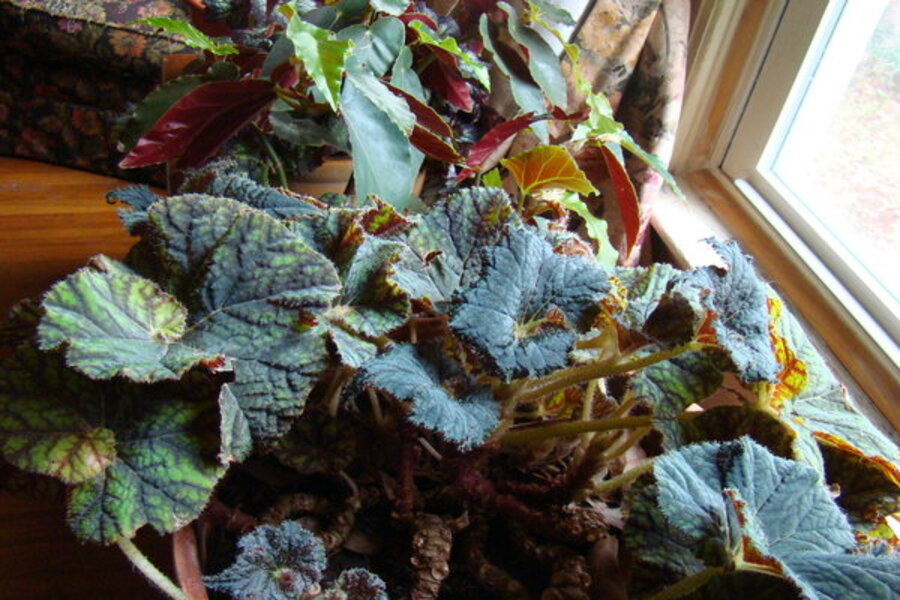Begonias in the bedroom
Loading...
Plants come with labels for many reasons, and my begonia collection is an ironic example of what can be gained by losing them. These specimens are beautiful cane, rhizomatous, and rex begonias, but sadly I may never know their proper names.
Eighteen months ago, a friend replaced the plastic on my tall hoop greenhouse and made the hard job look easy. In return, he left 10 huge begonias in my care. The greenhouse is barely heated; it's more for holding plants than actually growing them, and soon the begonias showed cold stress. Leaves drooped and didn’t recover, and some developed water-soaked spots.
Fearing their loss and that of my reputation, I dragged the cold, heavy pots indoors. Within a week, the begonias recovered, and I was confident I could return them to their owner intact. Spring came, and my friend congratulated me with the gift of these unlabeled begonias.
A search for names
Thus began a search that haunts me yet to definitively identify each one.
I had no idea how many begonias there are, nor how much they look alike! I found a friendly website in Brad’s Begonia World. The owner swears he’s working on its content, but I found plenty there to get started on my search for kinds, descriptions, names, and growing information.
Whoever they are, the begonias are mine now, and I’ve come to believe that rhizomatous begonias are the perfect houseplant. Like rex types, rhizomatous begonias are noted for dramatic leaves in lower-light spaces but these babies bloom reliably, too, most in late winter or spring. These non-rex types of rhizomatous begonias also tolerate lower humidity conditions without dropping leaves or muting their colors.
Some grow very upright, but most are nicely mounded. The green- and silver-leaved types are considered "common" (translation: easy to grow) by those who classify them, but I am no plant snob.
Distinctive appearance
There are two common rhizos in my collection, as well as two that are apparently known as "distinctive" types, and I love them all.
The gnarly rhizomes spread across the top of the container’s soil, root readily, and send up new leaf clusters at will. The plants are rough looking, distinctly hairy, and, for the most part, the leaves are hand-shaped and coarse-textured. That makes the delicate, star-shaped flowers borne on wispy stems appear as an ethereal cloud above the leaves.
I like that sort of Dr. Seuss-inspired contrast in a plant very much, which is probably why I grow oddball succulents, too.
It has addled my mind not to know the names of these plants, but I’ve given up after much searching through begonia photographs, including those in the database of the American Begonia Society.
I call my begonias The RB’s, just as I call mesclun seedlings The Messes because I forget exactly what’s in each mix that I plant. (I keep those seed packets, though, so I can always look them up if the need ever arises.)
Oddly, this situation is almost liberating for one who has spent a lifetime making sure to keep each label and know every plant’s lineage.
I loved horticulture school and took great pride in such things as knowing 10 oaks by name, leaf, and acorn, and 12 hollies on sight. I use that sort of specific information at least weekly as I answer gardeners' questions on radio and in my columns.
But it’s true that closely related plants have similar needs. Once I figured out which begonias were rex and which were rhizomatous, I didn’t need to know their proper names.
Begonia care
Rex types need more humidity, and I provide it the old-fashioned way by filling their saucers with pebbles. Spray the pebbles daily, and humidity around the plants increases. They also need more light to keep their leaf color, readily available in front of the windows on the south side of my house. The friendly RB’s perch on an old blanket chest in my bedroom alongside cane-type begonias.
Both have begun putting on buds in the bedroom, where the windows are large but the sunlight is never direct. I water them from the bottom to reduce the chances of marring my mother-in-law’s trunk, but also because it keeps the leaves dry.
Though I’ve never been one to let anyone into my bedroom whose name I don’t know, the RB’s are welcome. They forgive my lax habits, whether it’s forgetting to water them regularly or failing to make my bed.
-----
Nellie Neal, who's new to blogging at Diggin' It, gardens in beds and containers and on windowsills in central Mississippi and south Louisiana. She never met a plant she didn’t want to propagate. Her website is GardenMama.com.





